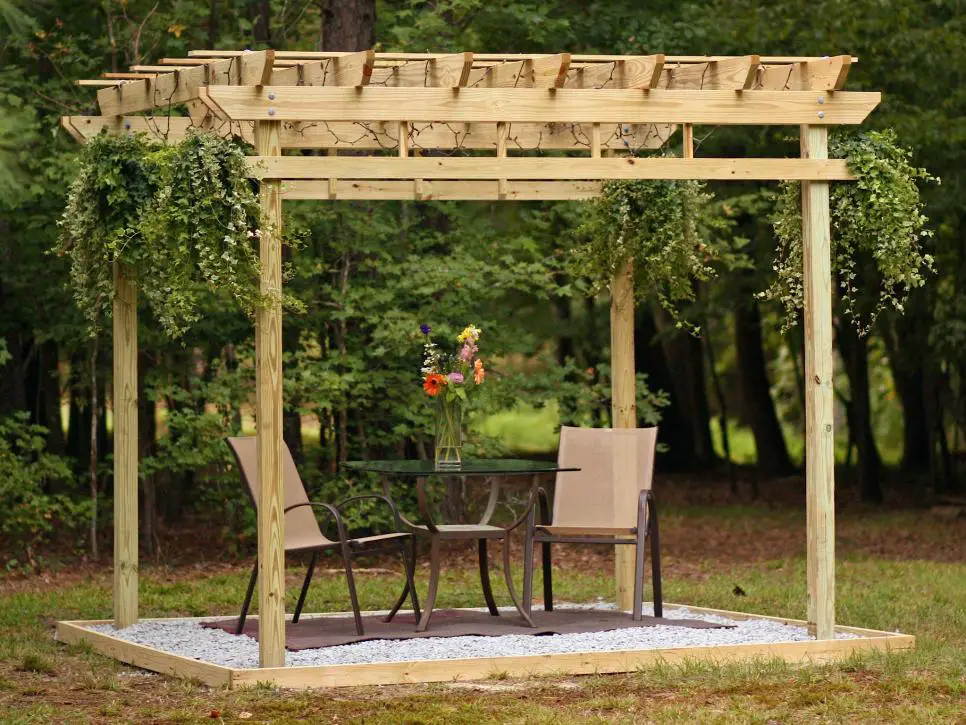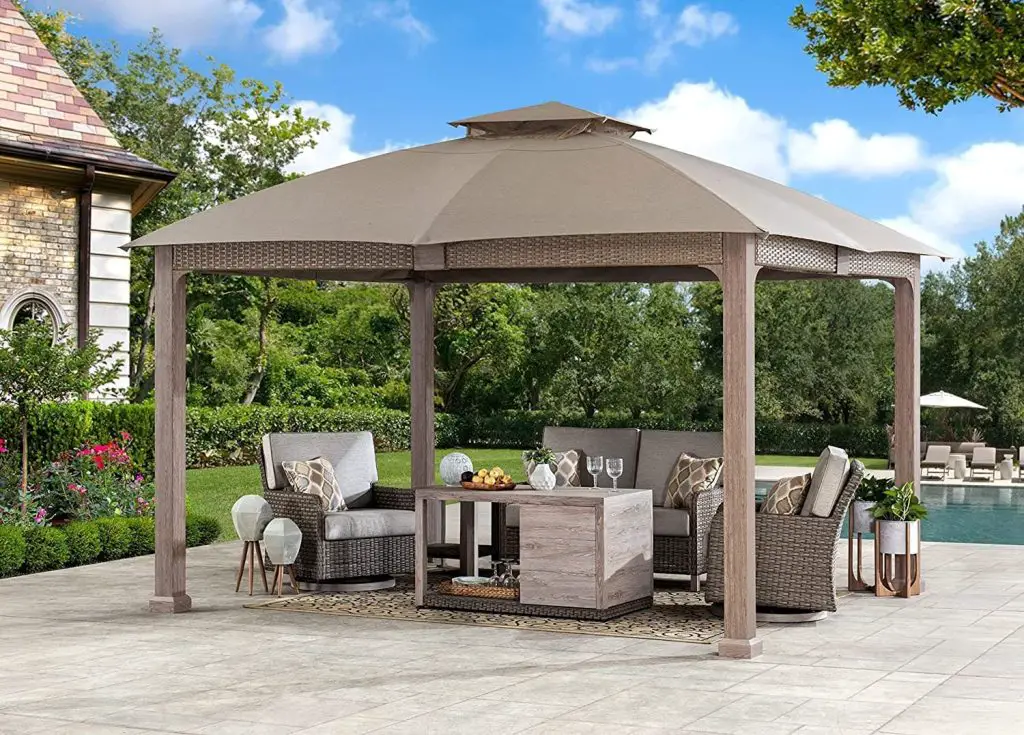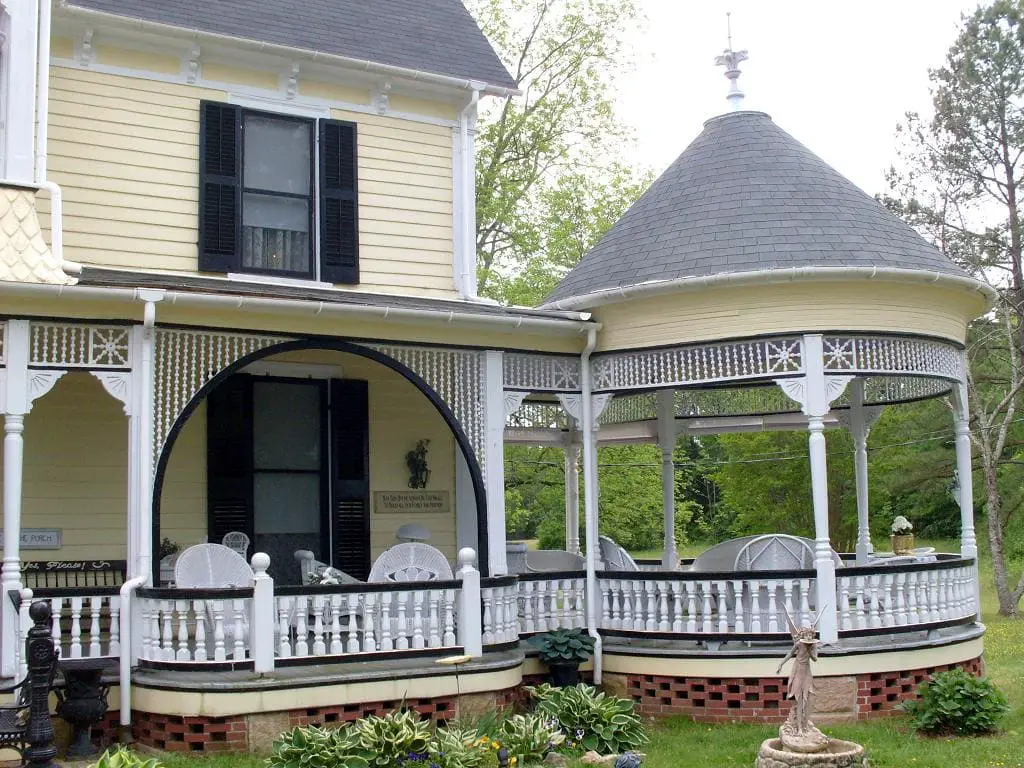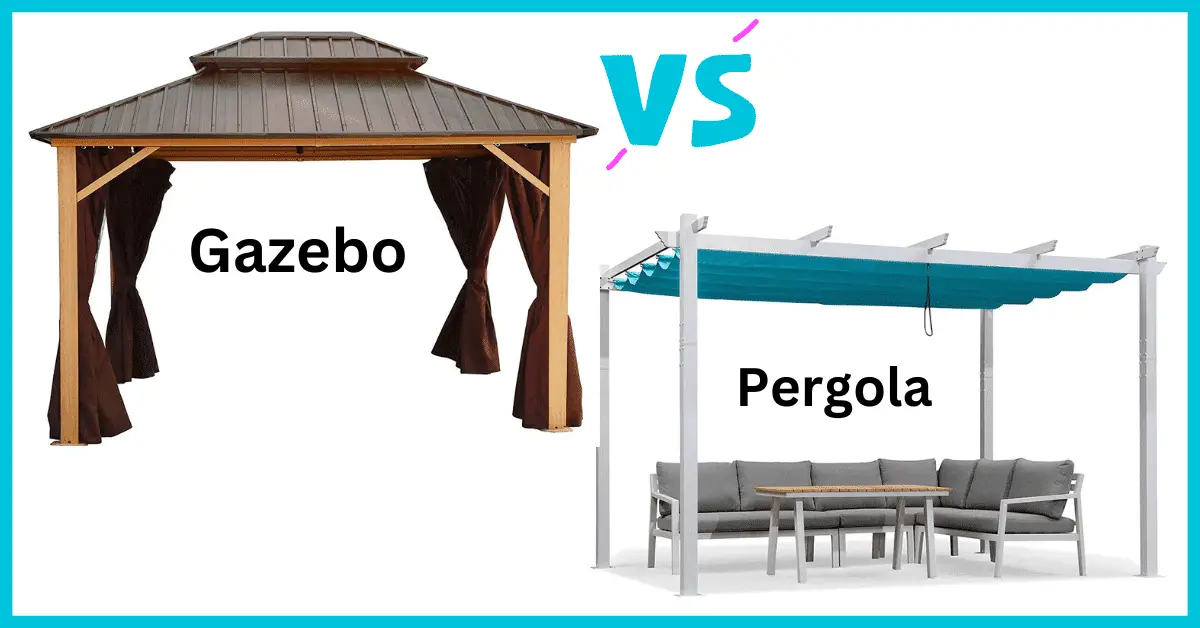For those seeking a place to escape and relax outside, look no further than the classic structures of pergolas or gazebos. These timeless additions bring style and shelter to any outdoor area, not to mention protection from harsh weather!
Before deciding which is suitable for your yard or garden, it’s essential to understand their differences. This article about Gazebo vs. Pergola dives in deep with all the pros & cons so you can decide what will best suit your space.
Create something special today while also enjoying its many benefits tomorrow.
Gazebo vs Pergola: A gazebo is a freestanding outdoor structure with a roof and open sides, providing shelter and defined space for relaxation or entertainment. On the other hand, a pergola is an open-air structure with an overhead lattice or framework that supports climbing plants, creating a shaded area with a more natural and decorative aesthetic.
Design difference:

A gazebo is a freestanding structure, usually in the form of an octagon or pavilion, with a roof and open sides. It usually has its base, made from concrete slabs or patio stones and can be put anywhere in your garden.
On the other hand, pergolas are more like an arbor or trellis; they consist of a structure with posts and latticework overhead, creating an open roof to allow some sunlight through while providing partial shade.
Functional difference:
Gazebos are multi-functional structures for outdoor dining, lounging, sunbathing, and more! They’re perfect for providing a shaded area to enjoy the outdoors without worrying about sunburns or rain.
Meanwhile, pergolas are ideal for adding decorative elements such as climbing vines and hanging plants that create an outdoor oasis. Pergolas can also be used to provide shade in areas where full coverage from the sun is not necessary.
Roofing Difference:

The distinctive features of a pergola or gazebo are often easily distinguished in their roofing.
While the framework for many pergolas consists of various types like wooden, aluminum, steel, and PVC beams connected to form an open lattice structure, on top retractable fabric canopies may be added for additional shade but not much else weather-wise.
Plant life is another way to add more coverage from above, with vines creeping overtop, offering shelter from sunrays and a cooling atmosphere beneath it!
Gazebos are a unique, eye-catching addition to any outdoor space. Whether you choose one with an Asian-inspired pagoda roof, classic tiled pavilion, or contemporary steel frame and fabric model, their pitched tops will ensure rain won’t spoil your relaxation time!
Generally featuring finished floors that can be raised from the surrounding area if desired and built-in seating for those who prefer it, gazebos provide ample protection while lending undeniable aesthetic appeal.
Materials Difference:
Pergolas are often made from wood or metal and can be custom designed to fit your outdoor area. Both material choices tend to lend a different look depending on the style you want to achieve, so it’s essential to consider them before making any decisions.
Conversely, Gazebos use heavier materials such as stone, brick, and stucco for the base and steel or aluminum for the roof. Many also feature decorative elements such as stained glass and lattices that add to its allure.
Gazebo offers more shade and shelter:

If you’re looking for outdoor shelter and shade, it’s worth considering a gazebo. Due to its roof covering the entire structure, there’s no doubt that it offers more protection than pergolas, but what kind of coverage is best?
The answer depends on your needs: if quick assembly time is key then lightweight pop-up gazebos are a great choice, while solid wooden versions with canopies offer similar levels of refuge.
Pergolas don’t usually have enclosed sides either, which makes them different from many types of gazebos (such as those fitted with mesh screens or roller shutters) ultimately, though, only you can decide which provides better cover in light rain!
Permanent gazebos can offer a haven from the elements, allowing you to customize your coverage based on features that best suit your needs.
The cost of Pergolas is more inexpensive than gazebos:
For a permanent addition to the garden, consider constructing your pergola! With its wide range of kits and custom building plans available for affordable prices using pressure-treated lumber, you can easily construct this structure within any budget.
Alternatively, if you’re looking for something that may need more frequent replacing down the road (but still cost-effective), gazebos are also great seasonal options with fabric covers or even polycarbonate panels in higher quality models.
While it’s easy to find both prefab gazebos and plans for custom-built ones, the price tag of a readymade option is far higher than that of a pergola. Building your own from scratch requires considerable skill and effort!
Pergolas Wall Attachment:

A gazebo may be the perfect choice if you’re looking for an outdoor structure to relax in but don’t want it attached to your home or other buildings.
Unlike pergolas that use walls or posts as support structures and require permission from local authorities due to size and location restrictions, standalone gazebos have no such rules, providing complete freedom of placement without worrying about compliance concerns.
So if you’ve been dreaming of having your private hideaway in the garden while still admiring nature’s beauty around you, go ahead and make those dreams come true with a freestanding Gazebo!
Both Structures Increasing Home Value:
Spending a few thousand dollars to upgrade your outdoor living space can dramatically boost the value of your home. The payoff depends on where you live; homes in warmer climates that allow for more year-round use will likely gain greater benefits than those up north.
While exact figures vary, many experts agree that sprucing things up with items such as gazebos and pergolas can provide ROIs between 50 – 80%, meaning each $1K invested could mean an additional half or three quarters at sale time!
Building a pergola or gazebo can add more than just aesthetic value to your home, it could also provide you with an outdoor living area that not only looks beautiful but will be immensely practical and enjoyable for many years.
As well as adding tangible marketable appeal, the structure adds charm and character to make a house stand out from its peers!
Installation difference:
Regarding installation, gazebos tend to require more skill and effort than pergolas, as most will come with pre-assembled components that need to be put together on-site. This may require additional help from professionals or experienced DIYers in some cases.
Conversely, Pergolas are generally easier to install, with fewer pieces and a simpler construction process. The downside is that they often lack the customizability of gazebos since they usually don’t come with pre-made canopies or screens.
There are many considerations when deciding whether to add a pergola or gazebo to your outdoor space. From the limitless design possibilities and differing levels of weather protection available in both options, it’s ultimately about what suits your specific needs and budget best!
gazebo vs pergola
The key distinction between a pergola and a gazebo lies in their roof design. Gazebos and pavilions offer complete protection from the sun, whereas pergolas feature a slatted roof that allows sunlight to filter through. Typically, pergolas provide partial shelter and shade, enhancing gardens, pathways, or patios.
Related Article: The Difference Between a Pergola and Gazebo, Explained
FAQs:
Q:1 Is a pergola cheaper than a gazebo?
A: Yes, a pergola is typically cheaper than a gazebo. Prefabricated gazebos are more expensive than building your own pergola from scratch using pressure-treated lumber. Additionally, gazebos require more skill and effort to install than pergolas.
Q:2 Can a pergola or gazebo increase the value of my home?
A: Yes, adding a pergola or gazebo to your outdoor space can increase the marketable value of your home. Many experts agree these structures can provide returns on investment (ROI) between 50 – 80%. Each $1K invested could mean an additional half or three quarters at sale time!
Q:3 How difficult is it to install a gazebo or pergola?
A: Installing a gazebo is generally more difficult than installing a pergola, as most gazebos come with pre-assembled components that must be put together on-site.
Pergolas are usually easier to install, with fewer pieces and a simpler construction process. However, they often lack the customizability of gazebos since they usually don’t come with pre-made canopies or screens. It’s essential to consider your specific needs and budget when deciding which one is right for you.
Q:4 What are the cons of a pergola?
The biggest con of a pergola is that it doesn’t provide as much protection from the elements as a gazebo does. Pergolas are open structures made with beams and rafters rather than walls or roofs.
This means they offer no shelter from wind, rain, sun, or insects. They also don’t have built-in seating like many gazebos do. Additionally, they require more maintenance due to their exposed nature.
Q:5 What are the pros of a gazebo?
Gazebos offer several advantages over pergolas in terms of protection and convenience. Most come with screens or canopies to protect against wind, rain, and insects. They’re also often pre-assembled or come with instructions for easy assembly on your own.
Additionally, their built-in seating can make them more comfortable for entertaining guests in your outdoor space.
Overall, gazebos offer more protection from the elements than pergolas do and are usually easier to install. They also provide more visual interest and customization options due to their enclosed nature.
However, they are more expensive than pergolas and may require additional help from professionals or experienced DIYers during installation. Ultimately, it’s important to consider your specific needs and budget when deciding which one is right for you!
Conclusion:
In conclusion, pergolas and gazebos offer unique benefits in aesthetic appeal, weather protection, and cost. When determining which structure is best for your outdoor space, it is important to consider the design elements you need and whether or not a freestanding option would be better for your particular situation.
Both options can add considerable value and charm to your home, but ultimately, it comes down to personal preference. Whether you opt for a pergola or gazebo, the possibilities are endless!
No matter which option you choose, with careful planning and execution, you can create an outdoor space that will be enjoyed by friends and family alike. With some effort, you can turn your dream outdoor area into reality!
After reading this guide, we hope you will be well aware of Pergola vs. Gazebo. Good luck with your project, and enjoy the process! We wish you all the best in creating a beautiful outdoor space for you and your loved ones. Thank you for taking the time to read this guide!

